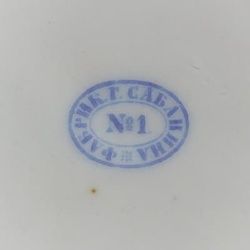
Фарфоровая фабрика Вавилы Сабанина.
Самая первая фабрика Сабанина была основана Вавилой Дмитриевичем Сабаниным в 1845 - 1848 годах в деревне Власовой Покровского уезда. В 1850-е годы фабрика переехала в местечко Климовка, а в 1869 году открылось новое предприятие по производству фарфора и фаянса в деревне Ратьково.
Вавила Сабанин работал у фабриканта Попова до того времени, пока не решил открыть свое предприятие. Имел ли к открытию фабрики отношение сам Попов - не известно, но он несомненно сыграл в его жизни важную роль, вдохновив на открытие собственного фарфорового производства. Вавила Дмитриевич, будучи заведующим живописном цехом, изучил все тонкости составления фарфоровой массы и гаммы красок, дружил с ведущими мастерами поповского завода, а главное - он оказался очень предприимчивым человеком.
Поначалу заимствование многих живописных мотивов было налицо.
Нежный голубой цвет крытья многих изделий очень роднил произведения В. Сабанина с произведениями фабрики Попова. В цветочных мотивах росписи тоже есть определенное сходство. Фабрика Вавилы Сабанина выпускала так называемый «трактирный фарфор», который отличался особой яркостью и выразительностью рисунка.
Крупные розы, вписанные в овал, или гроздья винограда придавали чайникам и чашкам выразительность. В росписи использовали и восточные мотивы, привлекавшие к себе внимание искусным плетением золотого орнамента. Если «трактирный» чайник отличался простой, округлой формой, то чайник из комплекта «Сказки Шехерезады» напоминает древний восточный сосуд. При этом на фабрике выпускали изделия и с простым рисунком по белому фону. Предметы украшались полевыми цветами и лентами золотом по краю чашек. Декоративные фигурки тоже имели место в ассортименте фабрики В. Сабанина.
Здесь преобладал жанровый мотив, а краски были сочными и яркими. Кроме столовой посуды и мелкой пластики на фабрике изготавливали аптечную посуду, которая всегда пользовалась большим спросом. В 1874 году, после смерти Вавилы Дмитриевича, фабрика перешла к сыну его Егору. До конца XIX века фабрика переходила по родственным связям от одного владельца к другому.







